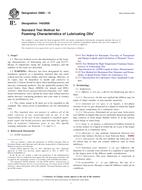Potřebujeme váš souhlas k využití jednotlivých dat, aby se vám mimo jiné mohly ukazovat informace týkající se vašich zájmů. Souhlas udělíte kliknutím na tlačítko „OK“.
ASTM D892-13
Standard Test Method for Foaming Characteristics of Lubricating Oils
Automaticky přeložený název:
Standardní zkušební metoda pro napěnění Charakteristika mazacích olejů
NORMA vydána dne 15.6.2013
Informace o normě:
Označení normy: ASTM D892-13
Poznámka: NEPLATNÁ
Datum vydání normy: 15.6.2013
Kód zboží: NS-39646
Počet stran: 11
Přibližná hmotnost: 33 g (0.07 liber)
Země: Americká technická norma
Kategorie: Technické normy ASTM
Kategorie - podobné normy:
Anotace textu normy ASTM D892-13 :
Keywords:
foam (foaming), ICS Number Code 75.100 (Lubricants, industrial oils and related products)
Doplňující informace
| Significance and Use | ||||||||||
|
5.1 The tendency of oils to foam can be a serious problem in systems such as high-speed gearing, high-volume pumping, and splash lubrication. Inadequate lubrication, cavitation, and overflow loss of lubricant can lead to mechanical failure. This test method is used in the evaluation of oils for such operating conditions. |
||||||||||
| 1. Scope | ||||||||||
|
1.1 This test method covers the determination of the foaming characteristics of lubricating oils at 24°C and 93.5°C. Means of empirically rating the foaming tendency and the stability of the foam are described. 1.2 WARNING—Mercury has been designated by many regulatory agencies as a hazardous material that can cause central nervous system, kidney and liver damage. Mercury, or its vapor, may be hazardous to health and corrosive to materials. Caution should be taken when handling mercury and mercury containing products. See the applicable product Material Safety Data Sheet (MSDS) for details and EPA’s website—http://www.epa.gov/mercury/faq.htm—for additional information. Users should be aware that selling mercury and/or mercury containing products into your state or country may be prohibited by law. 1.3 The values stated in SI units are to be regarded as the standard. The values given in parentheses are for information only. 1.4 This standard does not
purport to address all of the safety concerns, if any, associated
with its use. It is the responsibility of the user of this standard
to establish appropriate safety and health practices and determine
the applicability of regulatory limitations prior to use.
Standard Specification for Laboratory
Glass Graduated Cylinders Standard Test Method for Maximum Pore
Diameter and Permeability of Rigid Porous Filters for Laboratory
Use Standard Test Method for Kinematic
Viscosity of Transparent and Opaque Liquids (and Calculation of
Dynamic Viscosity) Standard Test Method for High Temperature
Foaming Characteristics of Lubricating Oils Standard Specification for ASTM
Liquid-in-Glass Thermometers |
Doporučujeme:
EviZak - všechny zákony včetně jejich evidence na jednom místě
Poskytování aktuálních informací o legislativních předpisech vyhlášených ve Sbírce zákonů od roku 1945.
Aktualizace 2x v měsíci !
Chcete vědět více informací? Podívejte se na tuto stránku.




 Cookies
Cookies
